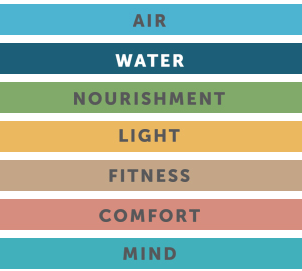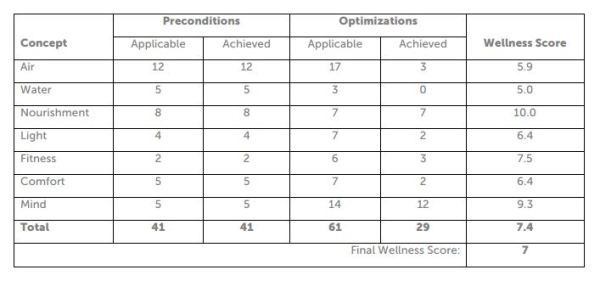Recent trends in energy efficiency and social and market forces and have spurred the development of green buildings. Green buildings are those that decrease energy consumption and CO2 emissions while providing employees with cleaner and healthier workplaces. Numerous studies over the years have proven that healthy workplaces improve employee morale and productivity while decreasing sick time and absenteeism. The foundation of green building design is cemented through energy efficiency improvements, most notably more advanced lighting, HVAC, and water systems, as light levels and clean, filtered air & water are vital to a healthy and productive workforce.
Not long after the green building revolution took sturdy roots in the United States, the WELL Building Institute (IWBI), an organization designed to foster health and well-being in the workplace, was founded. Shortly after the IWBI was formed, it developed the WELL Building Standard, an accreditation system based on seven Concepts that measures and scores the health of a building.
In this article, we’ll examine the seven Concepts of the WELL Building Standard, how WELL can drive business growth and development, and the crucial role energy efficiency plays.
The WELL Building Standard?
The WELL Building Standard is a building accreditation administered by the International WELL Building Institute (IWBI). The IWBI, launched in 2013, is a public benefit corporation that promotes public health and wellness in buildings and communities. Shortly after IWBI’s launch, the WELL Building Standard was created. A building with a WELL certification is one that proudly supports and advances human health and wellness.
WELL addresses seven Concepts to health and well-being: air, water, nourishment, light, fitness, comfort, and mind.
Source: Delos
Achieving the Well Building Standard starts by scoring these Concepts based on a ten-point system. The better the building performs in each Concept, the higher the award. The three awards a building can achieve are Silver, Gold, and Platinum.
Source: Architect Magazine
How WELL Can Help Grow Your Business
A building that embodies the values of the IWBI will drive business results. A recent article by the Boston Globe examines some of the benefits of a green building.
“A growing body of research shows that improving lighting, ventilation, and heat control improves workers’ performance, boosts their productivity, and even helps them sleep better at night. And developers and architects are starting to tout these benefits to potential tenants as a way to attract a higher caliber of employee — and get more work out of them.”
According to a study by Deloitte, companies that implemented green retrofits experienced the following results:
- 100% increased employee goodwill
- 93% increased talent attraction
- 87% improved workforce productivity
- 81% greater employee retention
- 75% improved employee health
Increases to productivity have proven to have a direct impact to an organization’s bottom line. A one percent increase in productivity can yield approximately $650 per employee. Lighting upgrades, one of the easiest improvements, can improve employee productivity by 3.2 percent. Furthermore, improving air quality by doubling the ventilation rate within a building is estimated to improve each person’s productivity equal to about several thousand dollars per year.
Source: Triple Pundit
How WELL Can Enhance Your Public Image
Green buildings are trending, and both employers and employees want to be part of a building that is sustainable, healthy, and energy efficient. To date, more than 300 projects worldwide, including seven in Massachusetts, are implementing procedures to achieve the WELL Building Standard. Proactively approaching measures to generate a more sustainable and efficient building fosters corporate social responsibility and attracts top talent.
WELL and LEED: Dual Certification
Due to the complimentary nature and similar rating system between the WELL Building Standard and LEED rating system, it is encouraged to become dual certified. The WELL Building Standard has stricter building requirements than LEED. In a Buildings.com article, Irene Nigaglioni, Partner at PBK Architects, notes: “If you’re going for WELL, you’ve already built the platform. It has prerequisites to get to the silver level, and by the time you’ve done that, you’ve accomplished LEED.”
Final Thoughts
Achieving the WELL Building Standard helps businesses grow both financially and culturally. Given current social and market trends, coupled with the success of the LEED program, the WELL Building Standard is poised to become an industry standard entrenched in the minds of medium-to-large-scale business owners across the country. Taking a proactive approach towards green building design could be the catalyst that further differentiates your business from the competition and positions it for future growth and development.






